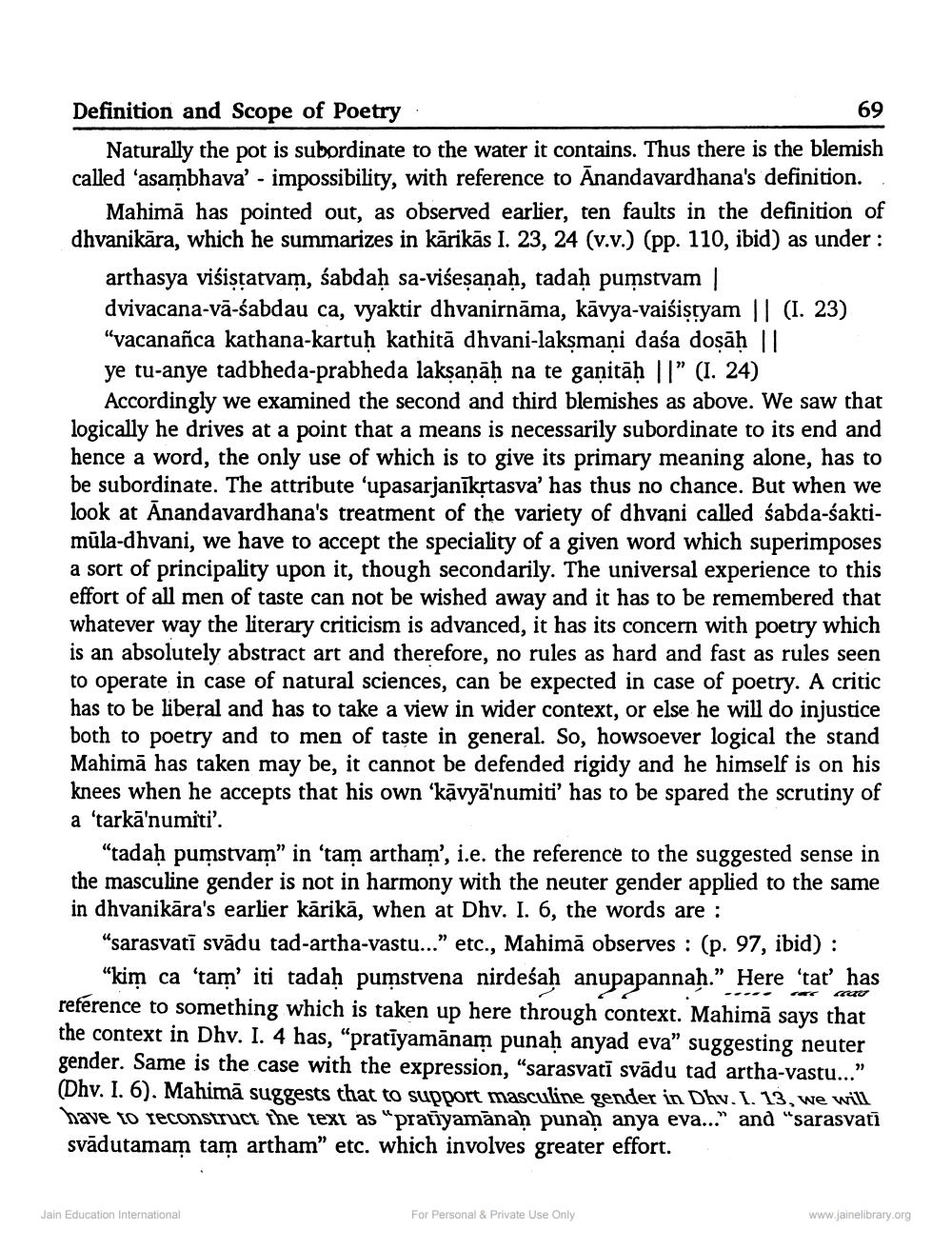________________
69
Definition and Scope of Poetry
Naturally the pot is subordinate to the water it contains. Thus there is the blemish called 'asambhava' - impossibility, with reference to Anandavardhana's definition.
Mahimā has pointed out, as observed earlier, ten faults in the definition of dhvanikāra, which he summarizes in kārikās I. 23, 24 (v.v.) (pp. 110, ibid) as under:
arthasya viśistatvam, śabdaḥ sa-viśesanah, tadah pumstvam dvivacana-va-sabdau ca, vyaktir dhvanirnāma, kāvya-vaisistyam || (I. 23) "vacanañca kathana-kartuḥ kathitā dhvani-lakṣmaṇi daśa dosāḥ || ye tu-anye tadbheda-prabheda laksaņāḥ na te ganitāḥ ||” (I. 24)
Accordingly we examined the second and third blemishes as above. We saw that logically he drives at a point that a means is necessarily subordinate to its end and hence a word, the only use of which is to give its primary meaning alone, has to be subordinate. The attribute 'upasarjanīkrtasva' has thus no chance. But when we look at Anandavardhana's treatment of the variety of dhvani called sabda-śaktimūla-dhvani, we have to accept the speciality of a given word which superimposes a sort of principality upon it, though secondarily. The universal experience to this effort of all men of taste can not be wished away and it has to be remembered that whatever way the literary criticism is advanced, it has its concern with poetry which is an absolutely abstract art and therefore, no rules as hard and fast as rules seen to operate in case of natural sciences, can be expected in case of poetry. A critic has to be liberal and has to take a view in wider context, or else he will do injustice both to poetry and to men of taste in general. So, howsoever logical the stand Mahimā has taken may be, it cannot be defended rigidy and he himself is on his knees when he accepts that his own 'kavyā'numiti' has to be spared the scrutiny of a 'tarkā'numiti'.
"tadaḥ pumstvam” in 'tam artham', i.e. the reference to the suggested sense in the masculine gender is not in harmony with the neuter gender applied to the same in dhvanikāra's earlier kārikā, when at Dhv. I. 6, the words are :
"sarasvatī svādu tad-artha-vastu..." etc., Mahimā observes : (p. 97, ibid) :
“kim ca 'tam iti tadaḥ pumstvena nirdeśaḥ anupapannah.” Here 'tat' has reference to something which is taken up here through context. Mahimā says that the context in Dhv. I. 4 has, "pratiyamānam punah anyad eva" suggesting neuter gender. Same is the case with the expression, "sarasvati svādu tad artha-vastu..." (Dhv. I. 6). Mahimā suggests that to support masculine gender in Dhy. I. 13, we will have to reconstruct the text as "pratīyamānaḥ punaḥ anya eva..." and "sarasvati svādutamam tam artham" etc. which involves greater effort.
Jain Education International
For Personal & Private Use Only
www.jainelibrary.org




